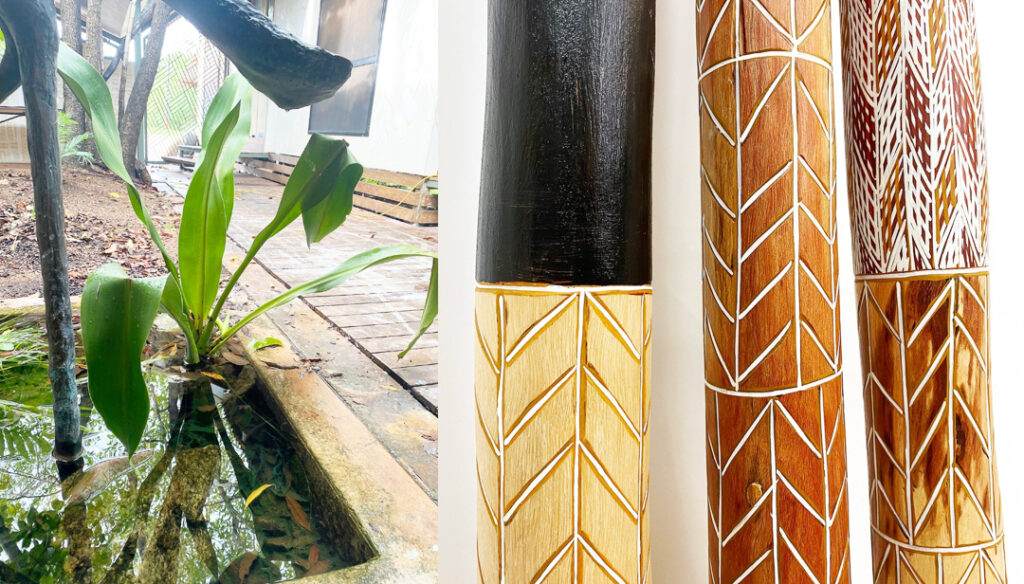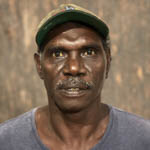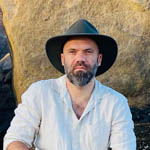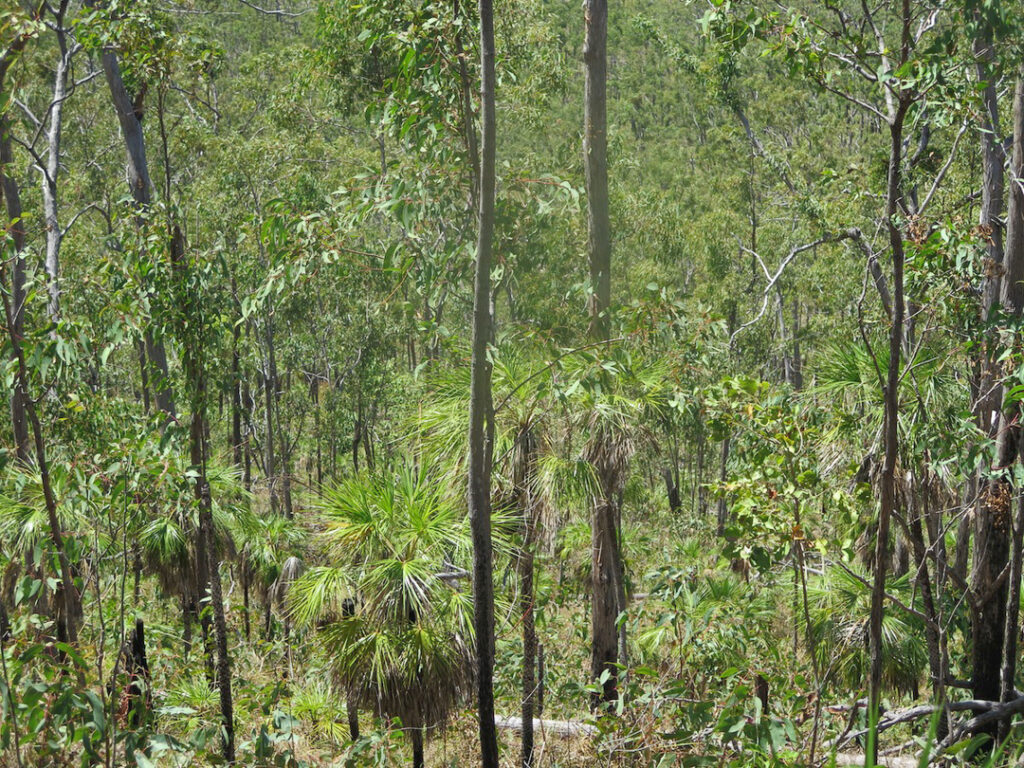Marikuku Wirrpanda and János Kerekes introduce the yiḏaki (didgeridoo) of Northeast Arnhem Land and give us insight into the skills and knowledge involved in the creation of this important Australian Aboriginal instrument.
Introduction by János Kerekes
I first heard the sound of the didgeridoo many years ago while growing up in a country far from Australia. As a young adult living in Budapest, I learned to play the instrument and devoured the generic information available. However, it was not long before my curiosity to learn more about its cultural origins led me to the decision to travel to Northern Australia to learn about this instrument first-hand. What started with one trip led to years, living and working in Arnhem Land with Yolŋu people. During this time I learned many things that extended far beyond the particularities of the didgeridoo. I realised that “learning first-hand” is not easy or linear, engaging cross-culturally requires time, relationships, language and self-reflexivity. I also learned that much of the information I had encountered in my early years was incorrect and did not adequately recognise and understand the cultural custodians of this unique instrument.
Let me introduce you to some of the basics I learned about this instrument first, we can make a visit to Yirrkala in Northeast Arnhem Land to talk to a master yiḏaki maker.
In this article, I use several characters that might be foreign to the reader, so it might be useful for the reader to learn about a few sounds used in Yolŋu languages. There are different sounds in the Yolngu Matha (matha means language or tongue) languages that are not used by English speakers. Before colonisation, Yolŋu did not have a written language. In the early twentieth century, different characters were introduced to write some of these languages. These include, ḏ (voiced retroflex sound with a `d`, sounds similar to yirdaki), ŋ (sometimes written as `ng`, sound similar to the `ng` in `sing`) or ä (long `a`, similar to the `a` in the English `star`).
Didgeridoo basics
The didgeridoo is an Australian Aboriginal aerophone instrument first developed by the Indigenous peoples of Northern Australia. Originating in Arnhem Land, the practice spread to the west, through the Daly River region to the Kimberly in Western Australia. Today it is played by Indigenous people across Australia. Whilst modern musicology classifies the didgeridoo as a brass aerophone or wooden trumpet, in its traditional context it is played as a rhythm instrument to accompany clap sticks and songs.
The didgeridoo is recognised as one of the oldest instruments in the world and, surprisingly, no structural changes have been made to it over time. The name didgeridoo, also spelt didjeridu, is a mainstream term that originates from the phonetic description of the rhythms played on the instrument in the Arnhem Land region. The word is used by both Aboriginal and non-Aboriginal people to refer to trumpets that are similarly played and belong to the didgeridoo-family. Northern Australia is one of the most linguistically diverse regions in the world and, consequently, there are numerous terms used for the didgeridoo in the Indigenous languages of this area. Some of the names include: artawirr in Iwaidja (Northwest Arnhem Land), kenbi in Wagadj (Victoria-Daly River region), djalubbu in Remarrnga (Central Arnhem Land), mako in Kunwijku, Kune and Kuninjku (Northwest Arnhem Land), yiraka in Andiliyakwa (Groote Eyelant) and maṉḏapul/maṉḏupul or yiḏaki in Yolŋu Matha (Northeast Arnhem Land).
The yiḏaki of Northeast Arnhem Land
Northeast Arnhem Land covers over 33 thousand square kilometres of the Arnhem region. Since time began the area has been occupied by several Indigenous clans who are connected through an intricate kinship system, shared religious beliefs, ancient traditional system of law, history and affiliation over their land. These clans speak their own language, share songs and ceremonial traditions, patterns, designs and symbols they use on paintings. Due to these shared traditions and connections, these clan groups blend into one cultural group and called themselves Yolŋu (read Yolngu). The map above indicates the location and size of the region. There are 60+ communities and homelands across the region, the map shows only a few to indicate the extent of the Yolŋu region.
The term yiḏaki is perhaps the most well-known Indigenous name for the didgeridoo. However, it is often incorrectly used to name or describe didgeridoos with superb playing qualities, authenticity, or to generically describe any Indigenous-made instrument. Rather, the yiḏaki refers to the didgeridoo made and played by the Yolŋu people of Northeast Arnhem Land. Several Yolŋu clans also have their own unique types of yiḏaki which are specifically crafted for their particular songs. The yiḏaki is embedded in Yolŋu spiritual beliefs where the sound of the instrument represents Ancestral power – it brings people together, calms the mind, heals and cleanses the body of the living and acts as a conduit to connect people to their natural world.
The yiḏaki is made of the naturally termite-hollowed stringybark eucalyptus logs (Eucalyptus tetrodonta), or gaḏayka in Yolŋu languages. At the start of the process, the yiḏaki maker finds trunks suitable for a didgeridoo by considering the shape of the log, the thickness of the wall and the size of the hole inside the tree trunk. The best didgeridoos are completely hollowed out by nature and finished by the maker only on the outside.
According to Yolŋu history, the yiḏaki was created by the Ancestors, who also brought into being the land, traditional Law, the clan groups and their languages. Since this time a particular playing technique has developed to accompany the traditional clan songs and dances. Passed down through generations, the playing technique is specific to Yolŋu culture, and its foundational method has not changed over time. In contrast, playing styles vary greatly between people, allowing for individual expression and musical innovation. This relationship between Ancestral constancy and individual creativity reflects the dynamic nature of Yolŋu culture and its capacity to respond to change.
The first yiḏaki – and didgeridoo – solo album released in 1977 on a 7″ vinyl LP, recorded by Rirratjiŋu clan leader Wandjuk Marika.
Different elements come together to create the unique sound of yiḏaki. The continuous airflow through loose lips creates the drone sound, which is maintained by a breathing technique called circular breathing. Simultaneously, the player’s voice cords boost the drone with overtones to give the sound a rich texture. The form of the instrument—its shape, length and wall thickness—meld with the player’s technique to create resonance, which is always specific to the player and his yiḏaki. Movements of the lips, tongue, cheeks, diaphragm and muscles of the lower abdomen further contribute to the sound and rhythm of the instrument. Skilled Yolŋu players as well as Balanda (non-Indigenous) researchers draw parallels between playing yiḏaki and the spoken language. Breathing, airflow pressure, movements of the muscles in different parts of the body, movement of the lips, cheeks and tongue all play an important part in the creation of human language, the same as the sound of the yiḏaki. Understandably, it takes years of training and practice to master playing the instrument.
Yiḏaki possess the finest qualities of instruments from the didgeridoo family, as Yolŋu have honed their craftsmanship since the Ancestral times. Yidaki makers design instruments to suit particular playing techniques and sounds. As such, skilled yiḏaki makers are highly sought after by both Yolŋu songmen and Balanda didgeridoo enthusiasts and art collectors. A good yiḏaki maker has expert knowledge of the bush where yiḏaki naturally grows, the eye to find the right stringybark tree and the skills to carve the hollow logs into instruments that play and resonate as desired. It is laborious work and only those with strength, skill and commitment will become master makers.
Let me now introduce you to Marikuku Wirrpanda, one of the most skilled yiḏaki craftsmen of Northeast Arnhem Land. As he demonstrates, yiḏaki makers develop the skill not only to hear, but also to feel the resonance of the yidaki through their fingertips. I recently caught up with Marikuku and Will Stubbs, co-ordinator of the Buku-Larrŋgay Mulka Centre in Yirrkala to discuss his practice.
Interview with Marikuku Wirrpanda
Artist profile:
Name: Marikuku Wirrpanda
Clan: Dhuḏi-Djapu
Moiety: Dhuwa
Language: Dhuwal
Homeland: Dhurruputjpi
Residency: Birany Birany
Marikuku Wirrpanda playing yiḏaki in Buku-Larrṉgay Mulka Centre in Yirrkala; recorded by Will Stubbs
JK: Marikuku, can you tell me about your gurruṯu? Tell us about your family and where you are coming from.
[Gurruṯu refers to the complex kinship system which forms the foundation of Yolŋu society. For Yolŋu, gurruṯu defines who you are and your relationships with everyone in the society.]
MW: Ŋarraku wäŋa Dhurruputjpi, ŋarraku father from there (My home is in Dhurruputjpi, my father is from there). He passed away.
JK: Yäkumiriw, ŋe (His name cannot be mentioned, is that right)?
[In Australian Aboriginal cultures the name of the deceased is banned for a number of years as part of the grieving. In Yolŋu language the term yäkumiriw is used to refer to the deceased, literally means ‘without name’.]
MW: Yow. [My] forefather name [is] Ṉambukul.
JK: Manymak (Ok). And how about your ŋäṉḏipulu?
[The term ŋäṉḏipulu refers to the clan where the mother of the individual belongs to. Ŋäṉḏipulu has a significant role in a person’s life.]
MW: Ŋayi Gumatj (She is from the Gumatj clan), [she is from] Birany Birany. We are staying there.
JK: Ga dhuwali wäŋa barrku (And is this place far from here) ?
Wife: Ŋe (that’s right) [it is] three hour’s drive from Yirrkala.
JK: Is it a big community?
MW: Nyumukuṉiny (small) community. Only six houses. I work on yiḏaki out there.
Google map showing Dhurruputjpi and Birany Birany. Homelands in Northeast Arnhem Land were established by Yolŋu leaders in the 1970s during a period known as homeland movement. These small communities often have only a few houses, usually occupied by the landowners’ gurruṯu. Dhurruputjpi is a homeland for the Dhuḏi-Djapu, Birany Birany lays on Gumatj clan land. These two clans bond together by strong relationships of inter-marriage, which is often referred to by the otherwise intricate concept of yothu-yindi.
JK: Where did you start making yiḏaki?
MW: [The] first didgeridoo [I made is ] from Dhurruputjpi, and second from Birany Birany.
JK: Manymak (Ok). Who taught you to make yiḏaki?
MW: Ŋathi’mirriŋu ŋarraku (My grandfather). Yiḏaki master. [I was] watching how he [was] playing and how he [was] doing didgeridoo. That is why I wanted to make yiḏaki, like this. [Showing yiḏaki in his hand]
[Gurruṯu differentiates grandparents on the father’s line and on the mother’s line; ŋathi is your father’s father.]
JK: Latju’ (Amazing) shape!
MW: Yow latju’ shape.
JK: Do you still remember the first yiḏaki you made?
MW: Ŋe (yes), it is similar to this one. And the carving one is my new style [ie. carving on the yiḏaki]. I did miny’tji (painting) first, and I got the idea for the carving. Balanda (white man) like this, the carving. Its name is ḏarraŋgi.
[The word miny’tji has multiple meanings: colour, painting, traditional design or specific clan design. It can be used to refer to both generic and specific Yolŋu art.]
JK: Ga nhä (And what is) ḏarraŋgi? [Marikuku turns to Will Stubbs]
WS: Hanguana Malayana. That is the one we have in the pond.
MW: That’s the one, ḏarraŋgi. Dhuwal (That is the) plant.

Ḏarraŋgi, freshwater palm (Hanguana Malayana) in the pond of the Buku-Larrŋgay Mulka Centre (left, Janos Kerekes, 2022), ḏarraŋgi miny’tji carved and painted on yiḏaki by Marikuku (right, Chloe Gibbon, 2022)
JK: Ga dhuwal ḏarraŋgi nhunŋu miny’tji (Is ḏarraŋgi your clan design)? So, your clan is singing this plant?
MW: Yow (Yes).
JK: Are you making other artworks as well?
MW: Ŋe (yes), painting, carving and making yiḏaki.
JK: Bathala djäma (Big job).
MW: Ŋe (Yes).
JK: Are you teaching djamarrkuḻi (children) to make and play yiḏaki?
MW: Only waŋgany (one), my boy. His name is George Milirrk #2 Wirrpanda. He is making yiḏaki with me sometimes.
JK: Talking about making yiḏaki, when you are out in the bush looking for yiḏaki, what are you looking for?
MW: Looking for the shape, ga wuthu-wuthun (and tap), tapping ga (and) looking for this sound. Old one sound, can you hear it?
Marikuku tapping yidaki
JK: Yow, manymak (yes, right). Ga (and) when you take the dharrpa (tree) home and start carving it, are you trying to get a specific sound out of it? Are you keep blowing it and shape the yiḏaki as you go?
MW: Yaka (no), I am looking for that sound [tapping the wood again]. If you find that sound, that’s [a good]
[Lit has multiple meanings:
- Lit means the base sound or the drone of the yiḏaki blown with medium pressure; playing the drone provides information to the player about the playing characteristics of the instrument such as volume, backpressure and acoustics.
- Lit can also refer to the sound of the yiḏaki played by Yolŋu in ‘historical times’, pre-colonisation up until the 1970’s. Due to the speed of the colonisation of the continent, Yolŋu culture remained relatively intact of white men’s culture until around the 1920’s. During the following decades western cultural values ignited changes in Yolŋu culture in accelerated level. These changes impacted the socio-spiritual life as well as the material culture, art and music – same as the yiḏaki playing style. In the ‘old days’ the sound of the ‘Old People’s’ yiḏaki was deeper in tone, the playing style was relaxed and slow, while nowadays higher pitched yiḏaki, fast rhythms and playing techniques are favoured.
- Finally, nowadays lit can refer to the sound played outside of buŋgul (ceremony), only for recreational purposes, or fun.]
JK: Manymak (ok), I am looking forward to see more yiḏaki from you.
MW: Ma’ manymak (ok, all good).
If you would like to see artworks from Marikuku, visit the Buku-Larrŋgay Mulka Centre website, or contact one of the Buku yidaki distributors close to you (Facebook).
Buku-Larrŋgay Mulka Centre is the Indigenous community-controlled art centre of Northeast Arnhem Land. Located in Yirrkala, a small Aboriginal community on the northeastern tip of the Top End of the Northern Territory, approximately 700km east of Darwin. Our primarily Yolŋu (Aboriginal) staff of around twenty services Yirrkala and the approximately twenty-five homeland centres in a radius of 200km. Buku-Larrŋgay Mulka Centre now consists of two divisions: the Yirrkala Art Centre which represents Yolŋu artists exhibiting and selling contemporary art and The Mulka Project which acts as a digital production studio and archiving centre incorporating the museum.
As our conversation shows, playing and making yiḏaki requires specific skills and knowledge. As he walks through the bush, Marikuku identifies suitable trees for an instrument, not only through sight but by tapping the log and listening to the resonance inside. At a time when Balanda are increasingly turning to yidaki as a way of forging greater connections with nature, Marikuku reminds us that yidaki’s place in the natural world extends far beyond the playing technique. He shows us that his knowledge of yidaki is embedded in his knowledge of his land which he knows through sight, sound, touch and smell. It is knowledge that comes from living on the land, as his family has done for generations. It comes from an understanding of being of the land.
In recent decades, interest in the didgeridoo has spread around the globe with thousands of enthusiastic players forming didgeridoo sub-cultures in Europe, America and Asia. Unfortunately, their distance from Arnhem Land makes it difficult to learn about the original sound of this unique instrument and often means its cultural ownership is not justly recognised. Aboriginal art has a great capacity to help us as Balanda understand and appreciate the differences between our cultures. Yiḏaki, and its sound, is a powerful tool to connect and communicate across cultural borders.
About Marikuku Wirrpanda
 Marikuku is the son of prominent artist and ceremonial leader Dh. Wirrpanda. He is known as the ceremonial yiḏaki player for the Dhuḏi-djapu clan and is often busy with ceremony. His skill as a player means he also has the knowledge to make top-quality yiḏaki. Marikuku has excellent attention to detail and his instruments are finished to a high standard. As a result, his yiḏaki have become popular quite quickly and his work is now sought after by both musicians and collectors worldwide.
Marikuku is the son of prominent artist and ceremonial leader Dh. Wirrpanda. He is known as the ceremonial yiḏaki player for the Dhuḏi-djapu clan and is often busy with ceremony. His skill as a player means he also has the knowledge to make top-quality yiḏaki. Marikuku has excellent attention to detail and his instruments are finished to a high standard. As a result, his yiḏaki have become popular quite quickly and his work is now sought after by both musicians and collectors worldwide.
About János Kerekes
 János is a didgeridoo promoter and cross-cultural facilitator. Born in Hungary, his keen interest in Australian Aboriginal cultures brought him to Australia. Over the past decade, he has been involved in cross-cultural work across Arnhem Land, working with Yolŋu to learn about their languages, cultural practices and worldview. János’ main interest is to develop tools for effective communication and engagement between Yolŋu and Balanda. Janos has been involved in the didgeridoo-art market for over 20 years, and in recent years has worked at Buku-Larrŋgay Mulka Art Centre.
János is a didgeridoo promoter and cross-cultural facilitator. Born in Hungary, his keen interest in Australian Aboriginal cultures brought him to Australia. Over the past decade, he has been involved in cross-cultural work across Arnhem Land, working with Yolŋu to learn about their languages, cultural practices and worldview. János’ main interest is to develop tools for effective communication and engagement between Yolŋu and Balanda. Janos has been involved in the didgeridoo-art market for over 20 years, and in recent years has worked at Buku-Larrŋgay Mulka Art Centre.
References
Buku-Larrŋgay-Mulka Centre. (2022). Marikuku Wirrpanda Bibliography.
Cloake, J. (2022). Yiḏaki: The Origin of Didjeridu. In Breath of Life. Switzerland: Fondation Opale.
Corn, A. (2003). Outside the hollow log: The didjeridu, globalisation and socio-economic contestation in Arnhem Land. Rural Society, 13(3), 244-257. doi: 10.5172/rsj.13.3.244
Graves, R. (2017). Yidakistory.com – Articles, Reviews & Reflections on Yiḏaki & Yolŋu Culture.
Ididj Australia [iDidj]. (2006, October 13). iDidj Australia YouTube Page [Video].
Kerekes, J. (2022). Didgeridoo basics – An Introduction to the Australian Didgeridoo.
Marika, W. (1977). Wanjuk Marika in Port Moresby, didjeridu solo [EP], (out of print). Australia: Larrikin.
Molye, A. M. (1981). The Australian didjeridu: a late musical intrusion. World Archaeology, and Musical Instruments, 12(3), 321-331.
Morphy, H. (1991). Ancestral connections: art and an Aboriginal system of knowledge. Chicago, USA: The University of Chicago Press.
Moyle, A. M. (1974). Songs from the Northern Territory: companion booklet (Revised edition). Canberra, Australia: Australian Institute of Aboriginal Studies.
Moyle, A. M. (Collector). (1997). Songs from the Northern Territory 1: Music from West Arnhem Land [CD]. Australia: Australian Institute of Aboriginal Studies.
Mununggurr, M. (2005). Hard tongue didgeridoo: Exercises in North East Arnhem Land yiḏaki style [CD]. Australia: Buku-Larrnggay Mulka Centre
Sherwood, P. (1997). The Didjeridu and Alternative Lifestylers’ Reconstruction of Social Reality. In K. Neuenfeldt (Ed.), The Didjeridu: from Arnhem Land to the Internet (pp. 139-154). John Libbey & Company Ltd., NSW.
Yunupiŋu, M. (1997). Yiḏaki. In K. Neuenfeldt (Ed.), The Didjeridu: from Arnhem Land to the Internet (pp. vii-viii). John Libbey & Company Ltd., NSW.





Comments
thankyou Marikuku & János for such an informatively in-depth exposure to the real gold behind the veneer of popular didj’ culture. The article and video are an absolute treasure for anyone seriously interested in the art and roots of didjeridoo .
In this issue of Garland Magazine, we read wonderful information, listen to wonderful mystical sounds… and make sense of how similar cultures are with elegant signs… The image that popped up in my mind while watching the first video of this article: I want you to see a divine Anatolian sky ceremony with the crane bird analogy.
“turna semahı”